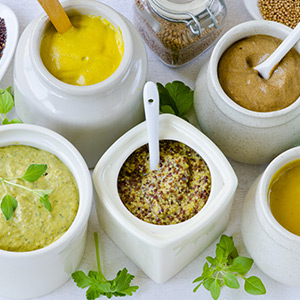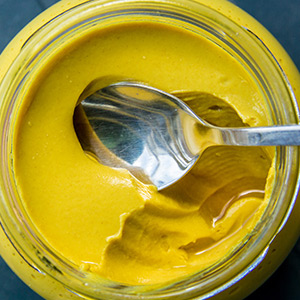Mustard

Did you know that Canada is one of the largest mustard exporters in the world? The popular homegrown ingredient comes from a plant in the cruciferae family, same as cabbage, broccoli and radish. In addition to the grains, the mustard plant also yields edible leaves and oil!
Mustard 101

- Three types of mustard are generally grown in the Prairies: yellow mustard (also called white), brown mustard and Chinese mustard.
- Mustard grains are ground, sifted or cracked to make the common mustard we find in jars.
- Whole mustard grains are generally used in the preparation of marinades or preserves. You can also use them in small quantity in mustard sauces to heighten flavour.
- Mustard leaves are small, dark green and can easily replace spinach. They can be sautéed, steamed or prepared raw for a salad.
- Mustard oil is extracted from mustard grains. Add a few drops of it to vegetable oil to spice up your homemade vinaigrettes and marinades.
Medicinal properties
- Mustard poultices is a natural folk remedy used to treat sore muscles, throats and nasal congestion associated with the common cold.
- Mustard stimulates the appetite and helps facilitate digestion because it activates the saliva glands and the production of gastric acid.
- Mustard has long been used to treat skin problems, because its sulphuric content has anti-inflammatory properties.
Types of mustards

Yellow mustard
We love this popular condiment for its sharp zing. Its bright yellow colour is owed to the curcuma it contains. Fun fact: Yellow mustard has been marketed notably under the French's trademark, which was named after its creator Charles French who unveiled this mustard in 1904 at the St. Louis World Fair and served it with hot dog sausages.
Dijon mustard
Dijon mustard is made of brown mustard grains grounded with vinegar and spices. It’s creaminess and colour is the perfect partner for cold cuts, vinaigrettes and dips, as well as egg, potato and pasta salads. It is also great as a rub for roasting meats.
Whole grain mustard
The coarsely cracked grains in whole grain mustard offers a more rustic texture for dressings, sauces and spreads. It also pairs well with veggies, such as tomatoes, raddichio and mushrooms. Try Moutarde de Meaux, a renowned, high-quality mustard first produced in 18th century Meaux, France.
Dry mustard
Easily recognizable in its little yellow metal box, this dry mustard is made with yellow and brown mustard seeds, ground to a powder. To reveal its full flavour, mix it with water or add a pinch to vinaigrettes, marinades or meat dishes.
Mustard any way
There are many varieties of specialty mustards in the market, flavoured with horseradish, tarragon, maple syrup and different herbs and spices. These can be used as marinades or slightly sweet condiments.










